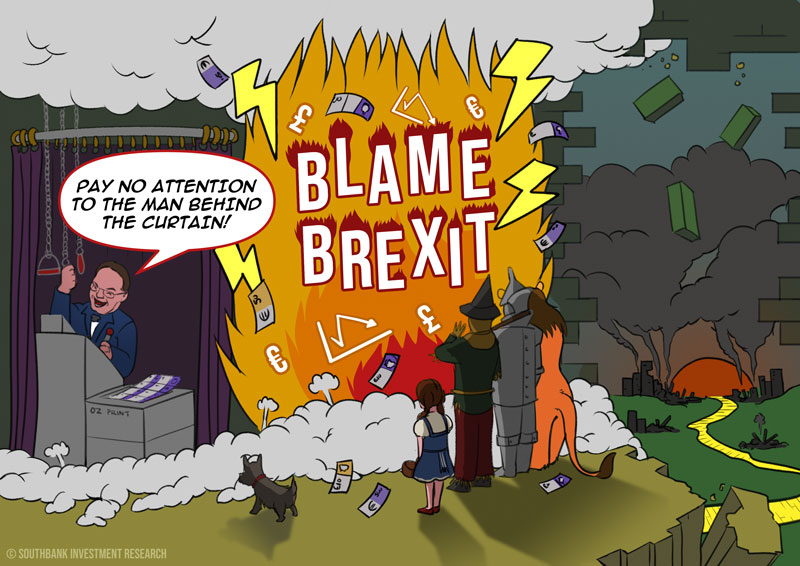- Inflation is a monetary phenomenon
- The Bank of England controls the money supply
- Yet it denies it is responsible for inflation!
“Pay no attention to the man behind the curtain!” exclaims the Wizard when discovered by a curious Toto and an astonished Dorothy. Tugging and pushing furiously at various ropes and levers, causing all manner of distractions, the Wizard was desperately trying to save the crumbling illusion of Oz.
Although most are not aware of this, The Wizard of Oz, a novel by L. Frank Baum, was an elaborate allegory of 19th century US monetary politics. The famous film is only loosely based on the book and leaves out many references to the topic, but some remain, including the “yellow brick road” symbolising the gold standard; and the green Emerald City, symbolising the “greenback” paper dollar currency printed by the Union to help finance the Civil War effort.
Greenback issuance was hugely inflationary. Combined with the real resource constraints caused by the war, prices soared. But following the war and huge spending on reconstruction, the greenbacks were redeemed and deflation and depression set in. Economic historians refer to this period in the 1880s-90s as the “First Great Depression”, preceding that of the 1930s.
That money printing can cause price inflation is well known. Prior to the introduction of purely unbacked, national fiat currencies, money printing and inflation were generally treated as synonymous by the economics profession.
That changed from the 1970s as unshackled central banks set about managing their economies more actively. The lags between money printing and realised consumer price inflation became ever more unstable anyway, due to financial innovation, and it became expedient to treat them as two separate things for policy purposes.
This was particularly the case during financial crises, when central banks would come to the rescue of one or more financial institutions, injecting money into the system as necessary. Amidst a financial crisis, money injections don’t easily flow through into consumer prices; rather, they provide interbank liquidity, buying the time needed to recapitalise the troubled banks.
To the extent such money injections were price inflationary, it would only show up years later, giving central banks a degree of “plausible deniability” for having contributed to higher consumer prices and stagflationary economic conditions.
As the decades rolled by, it became fashionable for central banks to target consumer price inflation explicitly. The Bank of England was one of the first to have a clear mandate to do just that.
For years, the BoE did rather well, consistently meeting its target of 2% inflation per annum. The BoE’s credibility grew. But notwithstanding, a global financial crisis arrived in 2008, and the British banking system faced collapse.
The BoE thus did what it has always had a mandate to do: print as required to keep the system liquid while politicians arranged a bailout for systemically important financial institutions. But this crisis and subsequent bailout were unusually large, as was the amount of money printed.
It took some time, but prices subsequently began to rise. Assets led the way, as they frequently do. House prices soared relative to incomes. Stock market multiples rose.
Economic historians are well aware that the above frequently if not always portend a general rise in the price level, although not on a consistent time horizon. After all, economies are highly complex, dynamic systems subject to all manner of exogenous and endogenous shocks.
Hence it was not until Covid supply constraints and spending largesse arrived that the general price level began to surge. More money was chasing fewer goods and services.
A global phenomenon, Covid lockdown and spending policies led to rising prices just about everywhere. In a few countries that had been more restrained in their money printing, such as Switzerland, prices rose far less. But they still increased.
The fact is, the elevated price inflation we face today has its roots in the banking system bailouts of 2008-9. Yes, subsequent developments eventually catalysed a shift from asset to consumer price inflation, but it can all be traced back to the money that has been printed throughout.
The BoE would prefer the public to see things differently. Over the past two years it’s blamed all manner of things beyond its control for the rise in prices: war, weather, pestilence, greedy workers… and now Brexit.
Two weeks ago, notwithstanding two years of what has been a clearly global explosion in prices, BoE governor Andrew Bailey blamed Brexit for the UK’s persistently high inflation in the face of higher interest rates.
Brexit has been to some extent disruptive, to be sure, but for the entire world? Britain is only about 5% of the global economy, so blaming Brexit is a stretch. It is far more straightforward to blame the global money printing spree that has been underway for years for global price inflation.
Governor Bailey’s latest wizardry is a 50bp rate rise, one that will no doubt add further pain to the UK housing market, which has all be seized up already as mortgage lenders pull offers. The UK is now all but certain to fall into what might well be a global recession.
As I’ve written before, investors should get defensive. This is easier said than done in what still remains an inflationary environment. But there are certain actions that can be taken. And there are always opportunities hiding in the rough.
That’s why we’ve created a free guide to protect yourself from one possible threat on the horizon: central bank digital currencies (CBDCs). As I’ve warned before, CBDCs will change the very nature of cash and bank deposits. By extension, this could have a substantial impact on the outlook for interest rates, bonds and stocks – and any typical investment portfolio would be affected in some way as a result. Which is why it’s important to act now.
Until next time,

John Butler
Investment Director, Fortune & Freedom
PS You may have noticed that today’s Fortune & Freedom looks a little different. We’re always looking to improve the look as well as the content of your publications. As always, we welcome your feedback, which you can do below.




